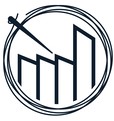Research can be Colorful!
Cotton and Clues: Building a Word Cloud to Explore the Textile Industry
I’ve always loved the idea of making research visual. There’s something satisfying about seeing your work take shape—not just in words on a page, but in images that reflect the heart of your topic. Recently, I created a word cloud to represent the textile industry, and the biggest word in it was Cotton. It felt right. Cotton is central to the story I’m telling, and seeing it front and center made the whole cloud feel alive.
But before I got to the fun part—choosing fonts and colors—I had to do the real work: research.
Starting with a Wide Net
When I begin a new project, I don’t dive straight into databases or archives. I start with a simple Google search. It’s like casting a wide net into the sea of information. I’m not looking for deep analysis at this point—just trying to get a sense of the landscape. Who’s writing about this topic? What are the key terms? Are there any authors or organizations that keep popping up?
This first step gives me a foundation. It’s where I gather the edges of the puzzle.
Following the Threads
Once I find a promising article or book, I start chasing its sources. I look at footnotes, bibliographies, and any mentioned works. This part feels like detective work—following clues to uncover deeper layers of the story. Sometimes one citation leads me to a whole new direction I hadn’t considered.
My Favorite Research Tools
When I’m ready to dig deeper, I head to the Databases A-Z list on the library website. It’s my go-to spot for finding reliable sources. I especially love JSTOR—it’s rich with journal articles and often helps me validate the information I’ve found elsewhere.
I also use Google Scholar when I’m hunting for books. It’s searchable, and sometimes it even links to previews or citations that help me decide whether a source is worth tracking down.
Keeping Track of It All
As I go, I keep a running list of sources in a simple Excel spreadsheet. It’s not fancy, but it works. I log every book, article, and journal I use or plan to use. It’s my personal works cited list, and it helps me stay organized—especially when I’m juggling multiple threads of research.
Putting the Puzzle Together
Researching feels like solving a puzzle. You start with scattered pieces, and slowly, the picture begins to form. Sometimes it’s frustrating. Sometimes it’s thrilling. But you keep going until your question becomes clearer.
And then—if you’re lucky—you get to turn that clarity into something beautiful.
From Research to Word Cloud
Once I had enough material, I started pulling out key terms: names, places, concepts, and of course, Cotton. These words became the building blocks of my word cloud. The bigger the word, the more central it is to the story I’m telling.
Creating the word cloud was more than just a creative exercise—it was a reflection of the journey. A visual map of the ideas I’d uncovered, the connections I’d made, and the story I’m still piecing together.
